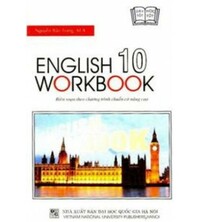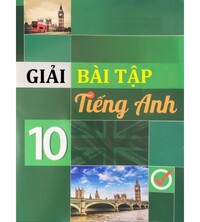3F - Unit 3. On screen - SBT Tiếng Anh 10 Friends Global
1. Complete the sentences with the correct form of the verbs below. 2. Read the text and answer the questions. 3. Read the Reading Strategy. Then read the text again and choose the correct answers.
Bài 1
1. Complete the sentences with the correct form of the verbs below.
(Hoàn thành các câu với dạng đúng của các động từ dưới đây.)
| cause | do | express | get | have | make | provide | take part in | use |
1. I often ____________________ online games like Minecraft with my friends.
2. Video games can ____________________ many benefits, such as improving memory and creativity.
3. The scientists ____________________ a lot of research on the topic and published the results yesterday.
4. I prefer to ____________________ a smartphone rather than a computer.
5. Video games can sometimes ____________________ a positive effect on teenagers.
6. The amount of violence in video games can ____________________ concern for a lot of parents.
7. Newspapers sometimes claim that video games are bad for children, and parents often ____________________ the same opinion.
8. Playing computer games in groups can help you to work together with other people and to ____________________ decisions more quickly.
9. Do you think playing computer games helps you to ____________________ better grades?
Phương pháp giải:
- cause: gây ra
- do: làm
- express: bày tỏ
- get: lấy
- have: có
- make: làm
- provide: cung cấp
- take part in: tham gia
- use: sử dụng
Lời giải chi tiết:
| 1. take part in | 2. provide | 3. did | 4. use | 5. have | 6. cause | 7. expressed | 8. make | 9. get |
1. I often take part in online games like Minecraft with my friends.
(Tôi thường tham gia các trò chơi trực tuyến như Minecraft với bạn bè của mình.)
2. Video games can provide many benefits, such as improving memory and creativity.
(Trò chơi điện tử có thể mang lại nhiều lợi ích, chẳng hạn như cải thiện trí nhớ và khả năng sáng tạo.)
3. The scientists did a lot of research on the topic and published the results yesterday.
(Các nhà khoa học đã nghiên cứu rất nhiều về chủ đề này và đã công bố kết quả vào ngày hôm qua.)
4. I prefer to use a smartphone rather than a computer.
(Tôi thích sử dụng điện thoại thông minh hơn là máy tính.)
5. Video games can sometimes have a positive effect on teenagers.
(Trò chơi điện tử đôi khi có thể có tác dụng tích cực đối với thanh thiếu niên.)
6. The amount of violence in video games can cause concern for a lot of parents.
(Mức độ bạo lực trong trò chơi điện tử có thể gây lo lắng cho nhiều bậc cha mẹ.)
7. Newspapers sometimes claim that video games are bad for children, and parents often expressed the same opinion.
(Báo chí đôi khi cho rằng trò chơi điện tử có hại cho trẻ em, và các bậc cha mẹ thường bày tỏ quan điểm tương tự.)
8. Playing computer games in groups can help you to work together with other people and to make decisions more quickly.
(Chơi trò chơi trên máy tính theo nhóm có thể giúp bạn làm việc cùng với những người khác và đưa ra quyết định nhanh chóng hơn.)
9. Do you think playing computer games helps you to get better grades?
(Bạn có nghĩ rằng chơi trò chơi trên máy tính giúp bạn đạt điểm cao hơn không?)
Bài 2
2. Read the text and answer the questions.
(Đọc đoạn văn và trả lời các câu hỏi.)
1. What does Jenny do? _______________
2. Which country did she visit? _______________
3. What kind of natural disaster did Jenny experience in 2011? _______________
STAYING SAFE
When you ask more people about the benefits of apps on their smartphone, they say they use them to play games, surf the net, keep in touch with people and organise social events. But Jenny Harlow, a scientist from London, has got an app that does something much more important: it warns her when she is in danger. The app is called Safety Tips and it gives users real-time earthquake and tsunami warnings. The Japan Tourist Agency had the idea for the app after the 2011 earthquake in Japan, when many foreign tourists in the country were confused about what was happening and what they should do. Jenny was on a business trip to Japan when the earthquake struck. ‘Although there are a lot of earthquakes in Japan, it was the first time I experienced one. All the warnings and information on the internet, radio and TV were in Japanese, and I couldn’t understand. It was really confusing and I didn’t know what to do.’ She had to rely on Japanese colleagues to help her.
The Safety Tips app sends an alert to users when a major earthquake happens, and also tells them if a tsunami is likely to arrive at the coast. The app gives lots of tips about what to do, where to go and how to stay safe, as well as a list of useful Japanese phrases such as ‘Is this an earthquake?’ and ‘Is it safe here?’ Importantly, all the information is in English, and there are plans to add other languages. The Japan Tourist Agency plans to advertise the app at airports and tourist information centres in Japan. In order to get the app, people visit a website and download it. ‘I’m coming to Japan again next year and I will definitely watch out for alerts from the app,’ says Jenny.
Phương pháp giải:
Tạm dịch:
Khi bạn hỏi nhiều người hơn về lợi ích của các ứng dụng trên điện thoại thông minh của họ, họ nói rằng họ sử dụng chúng để chơi trò chơi, lướt mạng, giữ liên lạc với mọi người và tổ chức các sự kiện xã hội. Nhưng Jenny Harlow, một nhà khoa học đến từ London, đã có một ứng dụng làm được điều quan trọng hơn nhiều: nó cảnh báo cô ấy khi cô ấy gặp nguy hiểm. Ứng dụng này có tên là Mẹo an toàn và nó cung cấp cho người dùng cảnh báo động đất và sóng thần theo thời gian thực. Cơ quan Du lịch Nhật Bản đã có ý tưởng cho ứng dụng này sau trận động đất năm 2011 ở Nhật Bản, khi nhiều du khách nước ngoài ở nước này bối rối không biết chuyện gì đang xảy ra và họ nên làm gì. Jenny đang đi công tác ở Nhật thì động đất xảy ra. “Mặc dù có rất nhiều trận động đất ở Nhật Bản, nhưng đó là lần đầu tiên tôi trải qua một trận động đất. Tất cả các cảnh báo và thông tin trên internet, radio và TV đều bằng tiếng Nhật và tôi không thể hiểu được. Nó thực sự bối rối và tôi không biết phải làm gì. "Cô ấy phải nhờ đến các đồng nghiệp Nhật Bản để giúp cô ấy.
Ứng dụng Mẹo An toàn sẽ gửi cảnh báo cho người dùng khi một trận động đất lớn xảy ra, đồng thời cho họ biết liệu một trận sóng thần có khả năng đến bờ biển hay không. Ứng dụng cung cấp nhiều lời khuyên về việc phải làm, đi đâu và làm thế nào để giữ an toàn, cũng như danh sách các cụm từ tiếng Nhật hữu ích như 'Đây có phải là một trận động đất không?' Và 'Ở đây có an toàn không?' thông tin bằng tiếng Anh và có kế hoạch thêm các ngôn ngữ khác. Cơ quan Du lịch Nhật Bản có kế hoạch quảng cáo ứng dụng này tại các sân bay và trung tâm thông tin du lịch ở Nhật Bản. Để tải ứng dụng, mọi người truy cập trang web và tải xuống. Jenny nói: “Tôi sẽ lại đến Nhật Bản vào năm tới và tôi chắc chắn sẽ theo dõi các thông báo từ ứng dụng.
Lời giải chi tiết:
1. What does Jenny do? He’s a scientist.
(Jenny làm nghề gì? Anh ấy là một nhà khoa học.)
Thông tin: “But Jenny Harlow, a scientist from London,…”
(Nhưng Jenny Harlow, một nhà khoa học đến từ London,…)
2. Which country did she visit? Japan
(Cô ấy đã đến thăm đất nước nào? Nhật Bản)
Thông tin: “Jenny was on a business trip to Japan when the earthquake struck”
(Jenny đang đi công tác đến Nhật Bản thì động đất xảy ra)
3. What kind of natural disaster did Jenny experience in 2011? earthquake
(Jenny đã trải qua thảm họa thiên nhiên nào trong năm 2011? động đất)
Thông tin: “Jenny was on a business trip to Japan when the earthquake struck”
(Jenny đang đi công tác đến Nhật Bản thì động đất xảy ra)
Bài 3
3. Read the Reading Strategy. Then read the text again and choose the correct answers.
(Đọc Chiến lược Đọc. Sau đó đọc lại văn bản và chọn các câu trả lời đúng.)
1. According to the text, most people
a. don’t value apps very highly.
b. don’t know what the main benefits of apps are.
c. use apps mainly for fun and social situations.
d. think apps are useless in dangerous situations.
2. The main purpose of the Safety Tips app is to
a. prevent an earthquake like the one in 2011.
b. warn people who are visiting Japan about earthquakes.
c. warn Japanese people about earthquakes.
d. warn business people about earthquakes.
3. Jenny had problems
a. because no one told her what to do after an earthquake.
b. because she couldn’t understand the advice on Japanese media.
c. because there was no information for tourists about what to do in an earthquake.
d. because her Japanese colleagues didn’t know what to do.
4. At the moment, the app
a. is available in a number of languages.
b. is available at airports and tourist information centres.
c. warns about earthquakes but not about tsunamis.
d. is in English, with Japanese phrases.
Phương pháp giải:
1. According to the text, most people
(Theo văn bản, hầu hết mọi người)
a. don’t value apps very highly.
(không đánh giá cao các ứng dụng.)
b. don’t know what the main benefits of apps are.
(không biết những lợi ích chính của ứng dụng là gì.)
c. use apps mainly for fun and social situations.
(sử dụng ứng dụng chủ yếu cho các tình huống vui nhộn và xã hội.)
d. think apps are useless in dangerous situations.
(cho rằng ứng dụng vô dụng trong các tình huống nguy hiểm.)
2. The main purpose of the Safety Tips app is to
(Mục đích chính của ứng dụng Mẹo An toàn là)
a. prevent an earthquake like the one in 2011.
(ngăn chặn một trận động đất như trận động đất năm 2011.)
b. warn people who are visiting Japan about earthquakes.
(cảnh báo những người đang đến thăm Nhật Bản về các trận động đất.)
c. warn Japanese people about earthquakes.
(cảnh báo người dân Nhật Bản về động đất.)
d. warn business people about earthquakes.
(cảnh báo những người kinh doanh về động đất.)
3. Jenny had problems
(Jenny gặp vấn đề)
a. because no one told her what to do after an earthquake.
(bởi vì không ai nói cho cô ấy biết phải làm gì sau một trận động đất.)
b. because she couldn’t understand the advice on Japanese media.
(bởi vì cô ấy không thể hiểu được lời khuyên trên các phương tiện truyền thông Nhật Bản.)
c. because there was no information for tourists about what to do in an earthquake.
(bởi vì không có thông tin cho khách du lịch về những gì phải làm trong một trận động đất.)
d. because her Japanese colleagues didn’t know what to do.
(bởi vì các đồng nghiệp người Nhật của cô ấy không biết phải làm gì.)
4. At the moment, the app
(Hiện tại, ứng dụng)
a. is available in a number of languages.
(có sẵn trong một số ngôn ngữ.)
b. is available at airports and tourist information centres.
(có sẵn tại các sân bay và trung tâm thông tin du lịch.)
c. warns about earthquakes but not about tsunamis.
(cảnh báo về động đất nhưng không cảnh báo về sóng thần.)
d. is in English, with Japanese phrases.
(bằng tiếng Anh, với các cụm từ tiếng Nhật.)
Lời giải chi tiết:
| 1. C | 2. C | 3. C | 4. D |
1. According to the text, most people
Chọn C: use apps mainly for fun and social situations.
Thông tin: “When you ask more people about the benefits of apps on their smartphone, they say they use them to play games, surf the net, keep in touch with people and organise social events.”
(Khi bạn hỏi nhiều người hơn về lợi ích của các ứng dụng trên điện thoại thông minh của họ, họ nói rằng họ sử dụng chúng để chơi trò chơi, lướt mạng, giữ liên lạc với mọi người và tổ chức các sự kiện xã hội)
2. The main purpose of the Safety Tips app is to
Chọn C: warn Japanese people about earthquakes.
Thông tin: “The app is called Safety Tips and it gives users real-time earthquake and tsunami warnings”
(Ứng dụng có tên là Mẹo an toàn và nó cung cấp cho người dùng cảnh báo động đất và sóng thần trong thời gian thực)
3. Jenny had problems
Chọn C: because there was no information for tourists about what to do in an earthquake.
Thông tin: “All the warnings and information on the internet, radio and TV were in Japanese, and I couldn’t understand. It was really confusing and I didn’t know what to do.”
(Tất cả các cảnh báo và thông tin trên internet, radio và TV đều bằng tiếng Nhật và tôi không thể hiểu được. Nó thực sự khó hiểu và tôi không biết phải làm gì.)
4. At the moment, the app
Chọn D: is in English, with Japanese phrases.
Thông tin: “The app gives lots of tips about what to do, where to go and how to stay safe, as well as a list of useful Japanese phrases such as ‘Is this an earthquake?’ and ‘Is it safe here?’ Importantly, all the information is in English”
(Ứng dụng cung cấp rất nhiều lời khuyên về việc phải làm, đi đâu và làm thế nào để giữ an toàn, cũng như danh sách các cụm từ tiếng Nhật hữu ích như 'Đây có phải là một trận động đất không?' Và 'Ở đây có an toàn không?' Quan trọng là tất cả thông tin bằng tiếng Anh)
Search google: "từ khóa + timdapan.com" Ví dụ: "3F - Unit 3. On screen - SBT Tiếng Anh 10 Friends Global timdapan.com"







